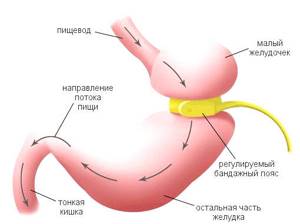Desperate to get rid of extra pounds through diets, exercise and other traditional weight loss methods, some turn to plastic surgeons for help. However, even successfully performed liposuction, which is a fairly invasive technique and has many contraindications, will not allow you to maintain a beautiful figure for a long time if you do not constantly monitor your diet and switch to a fractional diet. This is where sometimes the root of the problem is hidden, which a stomach ring for weight loss helps to solve.
Why does the stomach stretch?
People who are significantly overweight and have huge bellies are big food lovers. And often the standard lunch of such a glutton can easily feed two or even three people with modest appetites. And we're not just talking about calories. The total volume of such a meal can reach a liter or more (especially if everything is then washed down with tea or compote!).
The average person's stomach, when unstretched, is quite small. Its volume is slightly larger than a glass - approximately 200-350 ml. But the walls of the stomach are very elastic and can stretch quite a lot. This allows us to overeat with all sorts of goodies at the festive table or at friendly parties. But after such overeating there is always a feeling of heaviness, or even noticeable pain in the stomach.
When food is digested, the walls of the stomach contract again, and after a few hours it returns to its original volume intended by nature. But if the food taken earlier has not yet been digested, and a new portion of food is already entering the stomach, it stretches again.
At first, this causes constant discomfort, but gradually the stomach adapts to the increased load and becomes larger and larger.
What care is required after the procedure?
The patient must be treated with antiseptics and seal the puncture sites on the skin of the abdomen with a sterile plaster. Patients must constantly follow recommendations on nutrition and lifestyle, and visit an endocrinologist monthly. When stable weight loss is achieved, a doctor’s control is carried out once a year.
Nutrition rules after banding
The patient will have to follow the nutritional instructions for life. The patient's diet is not considered a diet, since the food must have all the components of a normal meal. The basis of nutrition should be solid protein products from fish, chicken, cheese, cottage cheese, vegetables and fruits in their usual form.
It is recommended to chew food thoroughly until it has the consistency of puree, and only then swallow. This condition helps reduce the possibility of digestive disorders. Nutritionists do not advise constantly consuming artificially crushed soups, cocktails, and casseroles. These dishes are high in calories.
Proper nutrition includes the following requirements:
- eating at least five times a day, in reduced portions;
- eating at a slow pace with good chewing;
- prohibition on drinking while eating;
- drinking up to 2 liters of liquid per day (except for sweet carbonated drinks, beer, alcohol);
- You can’t lie down and rest after eating.
After swallowing, it is recommended to pause for 60 seconds. This time is necessary for the esophagus for 2–6 pushing wave-like movements and complete passage of the lump through the bandage hole into the stomach. It is important to stay physically fit, at least walk more.
What is the problem
It would seem that the problem is small. You just need to stop constantly overeating, and your stomach will gradually acquire normal size. But then there would be no point in developing any operating techniques. They exist only because people with distended stomachs cannot stop overeating for physiological reasons.
The signal to the brain about satiety is sent only when the walls of the stomach acquire a certain degree of tension. We understand that we simply cannot fit more food into us.
The larger the volume of the stomach, the greater the amount of food that can enter it before the nerve impulse is sent to the hunger center.
Of course, you can force yourself to stop eating consciously by making a huge effort of will. But then the feeling of hunger will become a constant companion of a person until the stomach shrinks to its normal size, and this sometimes takes up to several months.
The mechanism of the bandage’s effect on digestion
After applying the band, the stomach cavity is divided into 2 parts: on top along the border with the esophagus - a smaller one, below - the main intact stomach. They are connected through a passage (stoma) that can be adjusted by filling or removing fluid from the cuff.
Food first enters the mini-stomach, then gradually moves down. The purpose of the operation is to achieve “deceptive” information from higher centers (hypothalamus) from the mechanoreceptors of the stretched upper area. The signal is transmitted along the nerves and “speaks” of satiety.
Thus, the patient is able to reduce the intake of calories from food without suffering from hunger.
Severely obese patients are at high risk of sleep apnea, which can be fatal.
Gastric resection
The first surgical method to solve this problem was vertical gastrectomy. This is a major abdominal surgery that was originally used to treat ulcers. Through a fairly large incision, the surgeon enters the abdominal cavity, cuts off part of the stomach, applies stitches and then closes the wound.
This type of gastric suturing has a number of obvious disadvantages:
- the operation is performed only under general anesthesia, which means it places a serious burden on the heart and kidneys;
- the integrity of the stomach itself is compromised, which is extremely undesirable;
- there is a high probability of infection of internal or external seams;
- after surgery, a long recovery period is required;
- for several months a person must follow a strict diet.
It is not surprising that very few people decided to have such a stomach reduction. And the surgeons themselves, without serious medical indications, performed it with great reluctance.

How the ring works
After a long fruitless search for a less traumatic way to shrink the stomach in order to lose weight, in the late 80s, the American doctor Lubomir Kuzmak proposed a very original solution to the problem. He was the first to come up with the idea of tightening the upper part of the stomach with an elastic silicone ring. And this idea worked!
In fact, the entire volume of the stomach was divided into two interconnected chambers. The volume of the top one is very small - no more than 20 ml. This is approximately two dessert spoons or four teaspoons. When the upper chamber is filled, a signal of saturation is sent to the person’s brain, and he no longer wants to eat more.
The food then gradually moves lower into the larger part of the stomach. And after a while the person wants to eat again. Thus, the patient is transferred to very small meals.
The daily volume of food eaten becomes approximately equal to the volume of the filled stomach. In 8-10 meals a person eats 20-30 ml of food.
Ring device
The bandage ring is not just a silicone roller, but a rather complex hydraulic system specially designed for such a procedure. It consists of three main parts:
- hollow silicone ring made of very durable and elastic high-quality silicone;
- thin elastic connecting tube;
- plastic port with a membrane made of high-tech materials.
This design is necessary so that the lumen of the ring can be adjusted, if necessary, and thus control the speed of passage of food through the upper part of the stomach.
The lumen is selected individually experimentally, based on how quickly the saturation signal arrives.
Benefits of banding
Installing a ring on the stomach is much easier than cutting off part of it. This can be done through a small skin incision on the abdomen. Additional benefits of gastric banding include:
- maintaining the integrity of the stomach walls;
- minimal blood loss;
- short rehabilitation period;
- reducing the risk of infection;
- possibility of adjusting cross-country ability;
- reversibility of the process (the ring can be removed).
The operation is performed using an endoscope, and after its completion, cosmetic sutures are applied, which after some time become almost invisible.
It is not surprising that this technique quickly became popular and is now successfully practiced in many cosmetic clinics.
Advantages and disadvantages
Compared to other bariatric surgeries, gastric banding in Moscow is the easiest and has the fewest complications. This is one of its advantages that patients talk about. There are others:
- There is no need to transect or remove organs.
- The width of the ring is easily adjustable.
- At the request of the patient, the bandage can be removed, due to which the functions of the stomach will be restored.
- If the patient is not satisfied with the results of the surgery, another bariatric procedure may be performed.
Perhaps, low invasiveness and reversibility are the only advantages of the operation. As practice shows, the effect of losing weight is not immediately apparent, and it manifests itself differently in each person. In addition, the cause of obesity must be taken into account. If the problem is overeating, then banding can really help. In case of hormonal disorders or diseases of the endocrine system, there is no point in performing surgery.
Despite its apparent simplicity, the procedure can have significant side effects:
- Discomfort while eating. It can manifest itself in different ways. Some patients note that food seems to get stuck in the stomach. Others complain of daily vomiting and difficulty adjusting.
- Infection enters the body along with the bandage. This happens in 4-5% of cases. It happened that I had to take care of all the infected bandages installed in a certain period of time. Unfortunately, compliance with antiseptic standards during this operation still leaves much to be desired.
- Port displacement or reversal. If the device changes its position, adjustment becomes inconvenient. However, this unpleasant case can be easily eliminated.
- Migration, slipping of the bandage. Since the stomach does not stand in one place, but constantly changes its position, the ring can slip off. To return it to its place, you have to either make adjustments again or resort to surgery.
- Erosion of the stomach. These are wounds, irritations on the body of the organ. They can occur as a result of ring displacement or infection. Statistics say that in 1% of cases the bandage can even grow into the stomach.
- Diaphragm hernia. A small section of the stomach can become overfilled and bulge towards the diaphragm, thereby creating conditions for the development of a hernia.
- Intestinal obstruction. The problem occurs as a result of not eating enough food, which reduces bowel activity.
As can be seen from the above, the procedure has many disadvantages, and it may not help everyone. Therefore, before the operation, it is necessary to consult with an experienced surgeon who will take into account all the nuances and help you make the right decision.
Preparation rules
In order to minimize all risks associated with the operation, the patient must be properly prepared for it. Ideally, the preoperative period consists of several successive stages, at each of which the doctor or the patient himself can decide to refuse the procedure.
Survey
A thorough examination is necessary to ensure that there are no medical contraindications, as well as to identify and prevent possible complications during the operation and the recovery period.
The list of necessary tests and analyzes in each case is determined by the doctor, but usually its integral part is:
- general and biochemical blood tests;
- blood clotting studies;
- tests for HIV, syphilis, hepatitis B and C;
- determination of blood group and Rh factor;
- fluorogram and ECG;
- gastroscopy and/or x-ray of the stomach.
A good doctor will definitely require that you first consult with a therapist and bring him an opinion about your general health.
Diet
Diet is needed already in the preoperative period. Its main task is to prepare the body for the transition to fractional nutrition, reduce the load on the liver and kidneys, and eliminate part of the visceral fat that covers the liver and interferes with the installation of the ring.
Doctors recommend that those losing weight stick to the following diet for at least a month:
- animal protein must be dietary - chicken breast or lean fish, boiled or steamed, no more than 200 grams per day;
- porridge and pasta with a minimum amount of oil and salt - 350-400 grams per day;
- fresh or boiled vegetables, salads with lemon dressing (no mayonnaise!) – 350-400 grams per day;
- 2-3 fresh apples or oranges, 1 grapefruit, a glass of fresh berries per day;
- vegetable soup 250-300 ml per day, meat, mushroom and fish broths are prohibited;
- dairy products - with a minimum percentage of fat content.
Sugar, sweets, canned fruits and packaged juices, soda, smoked meats and pickles, baked goods and confectionery are completely excluded from the diet.
Important! Those who manage to survive a month on such a diet often refuse surgery. It gives excellent results and has absolutely no contraindications.
Special training
A few days before the operation, it is necessary to take additional preparatory measures:
- stop taking aspirin and other blood thinners;
- do not use strong painkillers “Ibuprofen”, “Nurofen”, etc.;
- temporarily stop taking estrogens, even if they are prescribed to you by your doctor;
- 12 hours before surgery, do not drink or eat any food;
- Be sure to take a shower in the morning before surgery.
Even if you are very worried, do not take sedatives or sleeping pills - they can affect the quality of anesthesia. Warn the anesthesiologist at the clinic about this, and he will give you safe means in this situation that will help you relax.
Possible complications
The risk of complications after laparoscopic gastric banding is minimal. In the early postoperative period, only 2% of patients are diagnosed with pneumonia, bleeding and perforation (perforation) of the digestive tract.
In 4% of cases, complications such as migration of the band (moving through the stomach, its displacement), or fracture of a small ventricle are possible. In this case, patients will complain of heartburn, vomiting, constant pain in the epigastric region, and weight gain.
Complications associated with punctures are discussed separately. If sterility and disinfection measures have not been observed, then inflammation is possible. They will turn red, begin to swell, and serous-bloody fluid will be released from them.
Expert opinion
Yulia Mikhailova
Nutrition expert
Any deterioration in health, increase in body temperature, increased discharge from punctures is all a reason to immediately seek qualified medical help.
To prevent complications of the postoperative period, the doctor will prescribe painkillers for a maximum of 4 days. Weekly antibiotic therapy is mandatory.
Postoperative period
During the first days after surgery, the patient is always in the clinic. Although in most cases the recovery period is easy, we must remember that everything is individual. It is absolutely normal if, after installing the rings, you experience:
- nausea and vomiting;
- headache;
- feeling of heaviness in the stomach;
- Grumbling in the stomach.
Literally after 2-3 days the condition returns to normal. Nausea is usually associated with overeating, which most patients cannot resist at first. But if vomiting does not go away after 5-7 days, be sure to tell your doctor.
Diet after surgery
On the first day after surgery, you should not only eat, but also drink a lot. You are allowed to take only small sips every 1-1.5 hours. Every other day you can drink a little, but the total amount of liquid is at least 2 liters per day. This can be weak tea, still mineral, boiled or filtered water.
Then the doctor recommends a diet. The main menu is approximately the same as in the preoperative period, and the amount of food eaten is regulated individually according to how you feel.
The only restriction is that liquid and solid food should always be consumed separately. And you can drink no earlier than an hour after eating.
Installation method
The balloon is installed under gastroscopy control. This is not an operation, but an endoscopic procedure. It is performed under complete anesthesia. The patient may lie on their back or left side, depending on the physician's preference. A special medical dye, methylene blue, is introduced into a container of water intended for inflating the balloon (it is needed for timely recognition of leaks from the balloon). First, a gastroscopy is performed - an examination of the esophagus and stomach for the presence of diseases that may be a contraindication for the installation of a BIB. The balloon is then inserted through the mouth. A syringe is connected to the catheter, and under visual control, the balloon begins to inflate. In this case, the cover in which the cylinder is located is torn, and the cylinder is released. When the balloon is filled to the required volume (500 ml), the catheter is pulled out of the balloon and the valve closes. The balloon becomes a free ball in the lumen of the stomach. The catheter and gastroscope are removed from the patient. This concludes the procedure.
Contraindications
Although there are fewer contraindications for installing a gastric ring for weight loss than for resection, there are enough of them to make you think twice about whether it’s worth exposing yourself to all the risks associated with abdominal surgery. Banding is not performed if:
- pregnancy and if it is planned for the next couple of years;
- any blood diseases and bleeding disorders;
- thrombosis of the lower extremities and excess prothrombin in the blood;
- oncological, autoimmune and systemic diseases;
- violation of skin integrity and skin diseases in the abdominal area;
- cardiovascular, hepatic and renal failure;
- active inflammatory processes or viruses in the body;
- during the period of exacerbation of chronic diseases of internal organs;
- any serious disturbances in the functioning of the digestive system;
- liver cirrhosis and urolithiasis.
The operation is not performed on people with excess weight of less than 50 kilograms, as well as minors. Before making a final decision, the doctor must warn the patient about all the risks and possible postoperative complications.
Final results
Foreign clinics have accumulated more data on the outcome of treatment and goal achievement than in domestic bariatric surgery. Body weight loss looks like this: 3 months after the operation - 20% of excess weight is lost, and not the entire mass, after six months - 35%. Later:
- 12 months - 40%;
- 2 years - 50%;
- 4 years - 65%.
According to reviews of people who used gastric banding for weight loss, almost 19% of those operated on in foreign clinics were dissatisfied. Of these, half had to have the band removed due to complications.
Surgical treatment of obesity affects the digestive organs and disrupts the natural course of food processing. Therefore, patient selection is carried out strictly according to indications. Overweight people should not expect fabulous results. The consequences will also require a lot of patience and your own efforts.











